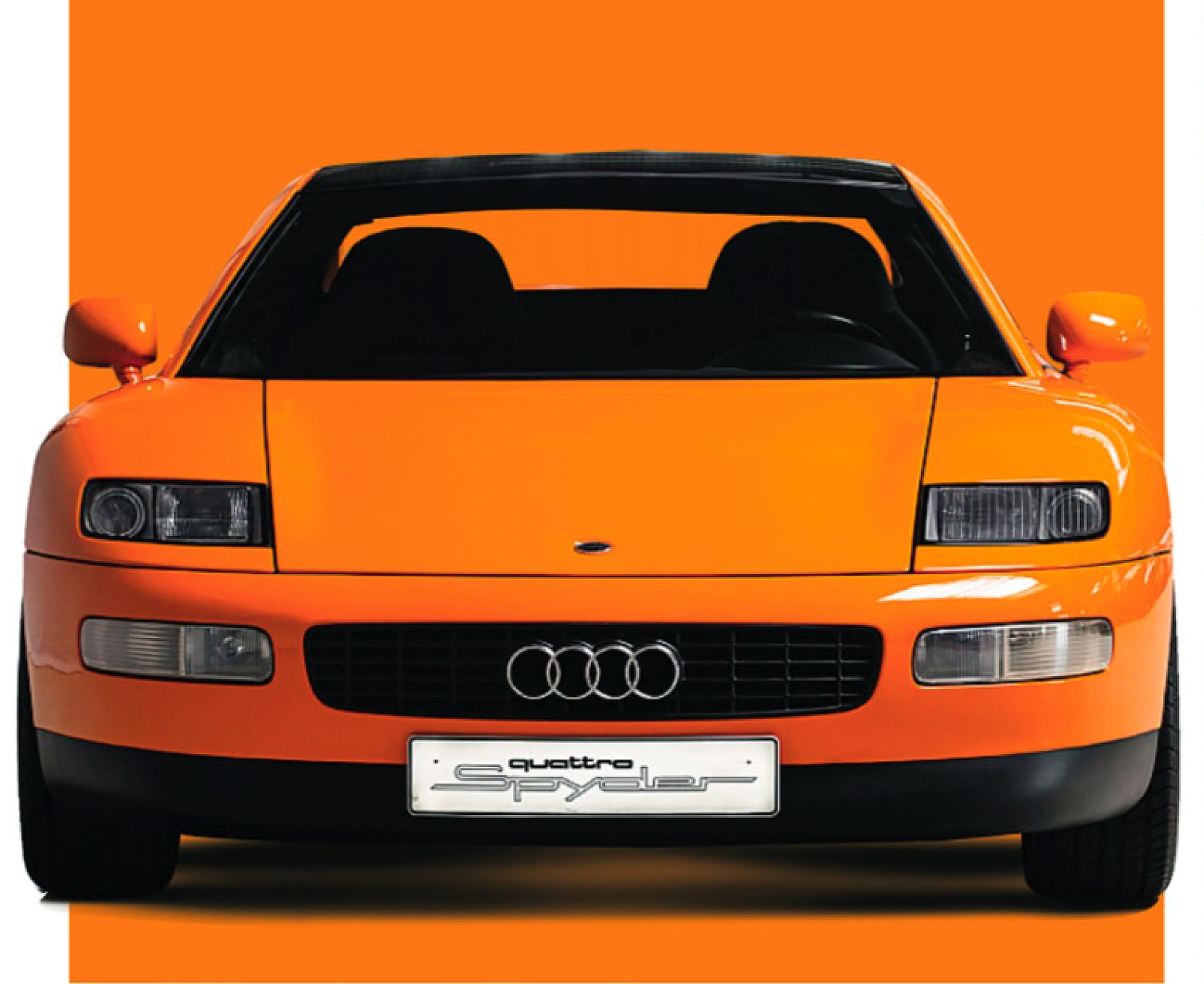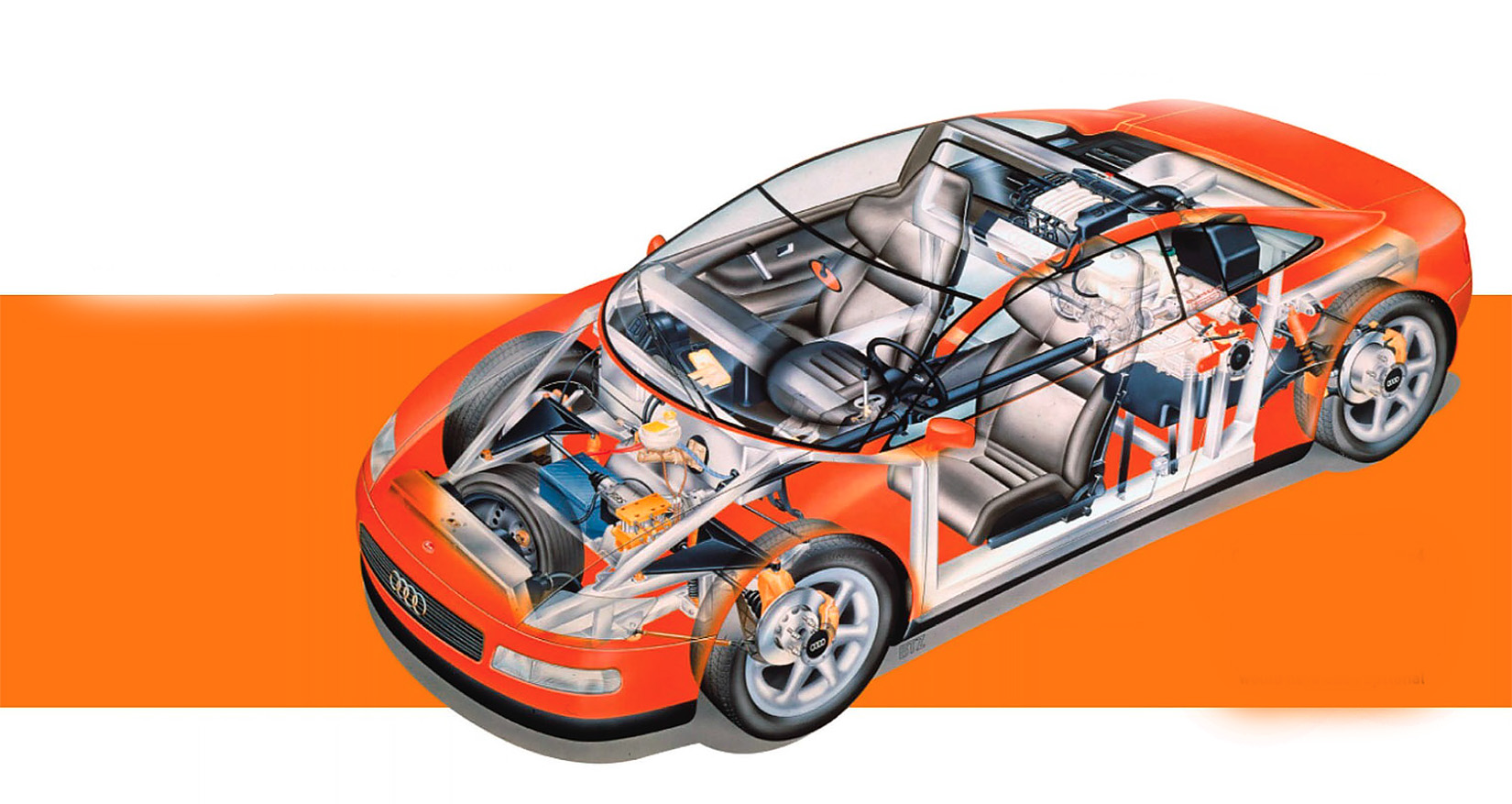
Tangerine dream – Audi Quattro Spider. Peter Robinson tells the story of the stunning quattro Spyder, the concept that Porsche didn’t want Audi to build. Photography Audi Tradition/Martyn Goddard.
This private mother-and-son moment somehow transcended their roles as European automotive nobility. The proud engineer son and CEO of Audi, Ferdinand Piech, parading his new concept quattro Spyder sports car to mum, Louisa Piech, on the first press day, Tuesday 8 October, of the 1991 Frankfurt show. Louisa, daughter of Ferry Porsche and quietly influential in the running of the family business, absorbed the beautiful, orange mid-engined coupe in all its detail, sat behind the wheel and listened as Ferdinand described the car. Finally, fully understanding its considerable potential to hurt Porsche, she looked straight at her son and spoke.

Cab-forward design still looks fresh 23 years after its debut. Removable glass top – hence the Spyder name – stows neatly above the engine cover and even incorporates a solar panel
“Ferdy,” she ordered. “Do not build this car.” With the company close to bankruptcy – Porsche built just 18,963 cars in 1991-’92 and, with 968 and 911 sales tanking, only 11,763 die following financial year – Louisa didn’t need to say any more. The idea of a brilliant contemporary rival from an Audi run by a member of the Porsche/Piech family was utterly reprehensible.
For the next six weeks, the quattro Spyder dominated the pages of the European motoring press, most stories consistently asking: would Audi build the glamorous sports car? Until, after that short time, it was utterly overshadowed by the Tokyo unveiling of Audi’s even more breathtaking, all-alloy W12 Avus supercar. This was Audi and Ferdinand Piech flexing their corporate muscles with two crucial image-building steps in the climb to take on and beat BMW and Mercedes as Germany’s supreme prestige brand.
“With a degree of swagger, we wanted to show the Japanese just what Europe was capable of producing,” Hartmut Warkuss, then head of Audi design, told Marco Degl’Innocenti in 2002. “This at a moment in which the Japanese automotive industry was threatening to submerge us with a tidal wave of new models.”

Yet, today, the still-gorgeous quattro Spyder remains largely forgotten. After the 1983 ‘aero’ 100, Audi – for which read Ferdinand Piech, then in charge of R&D – wanted to express its increasing design and technical talents via two show cars. The Avus was pure fantasy, a polished silver extravagance that drew on Auto Union’s 1930s racers for its inspiration, but with no realistic chance of production. So the creative team decided to simultaneously build another, more practical and production realistic, mid-engined sports car with the aim of a limited run at a still unknown price.
Officially, Audi claimed only that ‘it should be possible to keep to a five-figure DM selling price,’ but in the months following its unveiling, rumours of a projected DM60,000 price (10% below the 911) were not denied by Ingolstadt.
Within days of the Frankfurt show, Audi had 3000-plus firm orders for the Spyder, enough to force investigation of production – Louisa Piech notwithstanding. Audi’s September 1991 press release states: ‘Although the designers of the quattro Spyder were given a relatively free hand, they still had to keep to a number of specific targets: the study illustrates advanced weight- saving techniques in a fully functional car, and had to be capable of series production without changes to the basic concept.’
Fully functional is not quite accurate: the show car was a runner, but only in a straight line. Rails beside the front wheels to support the body resulted in a 25-metre turning circle. The packaging of the rolling chassis wasn’t much better: the V6 needed to be removed for a major service while the 70-litre fuel tank sat above the gearbox, mounted at the end of the engine.

Clockwise: squat stance; subtle badge; ally-bodied Avus was unveiled shortly after Spyder; lamp strakes like a DS; nicely appointed cabin; 18in Speedline alloys were vast for 1991.
Among the 478 cars and 200 motorbikes in Audi Tradition’s collection are that original 1991 show car and, to show how close the quattro Spyder went to production, the engineering rolling chassis. Ralf Friese, one of two historians who work at the museum, knows the car’s fascinating story and filled in the details.
The two Audi concept cars were designed concurrently, but not in the same studio: Martin Smith (who now runs Ford’s European studios) and J Mays (recently retired as Ford’s global head of design) were responsible for the Avus while, working in Audi’s advanced Munich studio, Erwin Himmel and Peter Schreyer styled the quattro Spyder. According to Hartmut Warkuss, then head of Audi design, the two cars were finished on the same day.
Porsche apparently investigated the possibility of fitting the 928’s v8 engine
Design work on the Spyder began in July 1990 and the proposal was settled by February. In 1992, exterior designer Himmel told the Audi Magazine: “Most [traditional supercars] are too big, too heavy, too complicated. A 300 horsepower heavyweight with lots of playthings and equipment may be all right on the autobahn, but it’s no fun on normal roads.

Cutaway shows Audi’s 4×4 running gear, including a Torsen centre diff and a manual rear diff lock. A four-speed automatic would have been optional.
“The mid-engined layout gives the best, most balanced handling, with the power behind your back, and you can see the road ahead through a low’ deep windscreen.” The car’s compact dimensions were seen as a real plus. “I like the proportions,” Himmel says, pointing to the long wheelbase and short overhangs. “You need the stubby tail to emphasise the car’s direction and mid-engined layout.” After the Frankfurt show, Audi sent both cars to Arizona to be photographed by Peter Vann, then the darling of automotive photography in Germany and Italy. For this exercise the quattro Spyder was repainted green, leading to suggestions that Audi had made two full-sized cars.
“We were trying out colours,” admits interior sty list Schreyer, who travelled to Arizona for the shoot, “but it was die same car resprayed.” The diminutive, four-wheel-drive sports car was powered by Audi’s then-new, off-the-shelf 2.8-litre V6, unchanged from its tune in the 100, with a modest 172bhp at 5500rpm and 181 lb ft of torque at 3000rpm. The engine was turned through 90° and mounted transversely, driving via a five-speed manual ’box, a Torsen centre diff that automatically varied the front/rear torque split, and a manual rear differential lock from the four-wheel-drive Golf Syncro. A four-speed self-shifting transmission was an easy option.
The front suspension was a freshly designed double-wishbone set-up and the rear by coil- sprung struts with additional transverse links. The elegant six-spoke 18in wheels (by Speedline and much copied) were huge in 1991, even if the 205/55 ZR18 rubber seems modest today. The designers also gave the quattro Spyder a removable glass roof – with solar panel – that clips neatly out of the way above the engine cover.

Below right: exterior designer Himmel was pleased with the quattro Spyder’s proportions: “The stubby tail emphasises the car’s direction and its mid-engined layout”. Clockwise: compact Audi is just 5ft 9 1/2in wide; full set of black-on-white instruments; Robinson gets the gen from Friese; transverse V6; race-style filler reappeared on TT.
Audi claimed a 48:52 front: rear weight distribution. Friese dismisses the target 0-100kph in about 6 secs and 250kph (156mph) top speed as optimistic, even if the car weighed the estimated 1100kg (2425lb). Much to the annoyance of Audi’s Neckarsulm-based aluminium experts, then working on the new all-alloy A8, the head of pre-development Fritz Naumann preferred to use an outsider. He appointed IAD, a British contract engineering and design house, for the alloy body and tubular spaceframe.
As the Ingolstadt engineers developed the rolling chassis ‘feasibility study’ – total budget just DM10m, or around $7.5m – they quickly realised that the 4.22m-long (13ft 10in) concept car needed a significantly bigger cabin if it was to go into production. They stretched the wheelbase by 100mm to 2640mm (8ft 8in) to improve interior room, while retaining the 1173mm height (3ft 10in) and slender 1768mm (5ft 9 1/2in) width. The front axle was moved forward, door width increased and the tail end revised, although the blue clay model of the longer car has long since been scrapped.
Happy with their progress and the car’s obvious potential, the big question quickly became: who is going to build it? Audi projected total sales of 25,000 cars over the quattro Spyder’s lifecycle, too small a number to warrant assembly in-house. Instead, it contacted various subcontract companies: Karmann, Valmet (which would later build the Porsche Boxster), Heuliez and, most intriguing of all, Porsche.
‘Rumours of a price 10% below the 911’s were not denied by Ingolstadt’.
Just two years earlier, to help struggling Porsche, Mercedes commissioned the 500E, a V8-powered W124, partly developed by Porsche and built in Zuffenhausen at the rate of c500 a year between 1990 and ’94. Then, from March 1994 to July ’95, Audi ordered 2891 RS2s.
Today nobody seems to know if the idea came from Porsche or Audi, but there was serious discussion between Ingolstadt and Weissach, Porsche s research centre, regarding Porsche producing two versions of the quattro Spyder.
The first, of course, was the Audi; the second was to be a Porsche. This would be history repeating itself: from 1969 to ’76, VW/Porsche built and sold the mid-engined 914 in four-cylinder VW form and with a flat-six for Porsche, both developed at Weissach by Ferdinand Piech, who then worked for the family firm. And the idea would presumably keep Louisa Piech happy.
Porsche apparently investigated the possibility of using the 928’s V8 engine, but the big, dry-sumped, quad-cam motor was too tall to fit – although it was later employed to create a 100 V8 as preliminary work on the first Audi V8 saloon, the predecessor to today’s A8.
Instead, the plan was to drop the 911s air-cooled flat-six into the quattro Spyder and sell this rear-drive version as a Porsche through its dealers. As far as we know, the idea didn’t go as for as building a prototype at Weissach and was quickly and quietly killed off.
In mid-1992, with sales of the B4 Audi 80 slumping along with profits, the board of directors decided that the quattro Spvders return on investment didn’t justify the effort and cancelled the project. Knowing that every quattro Spyder bought could have been at the expense of a 911 sale, nobody doubts that subtle pressure from the Piech/Porsche family also played a role.
Says Friese, dismissively, of the quattro Spyder: “With its transverse engine, it had nothing in common with anything then in production and didn’t influence anything in the future.”
The company’s fortunes only picked up with die hugely successful 1994 launch of the B5, now renamed A4. A few months later Audi design began work on another sports coupe, the front- drive or quattro, Golf-based TT.
Those on the team fondly recall the quattro Spyder. “It was the first concept I was involved with and I’m still proud of it,” says Schreyer, now head of design at Hyundai and Kia.
Hartmut Warkuss holds the quattro Spyder in equally high regard: “It was a car that immediately appeared to be very agile, with a high appeal. Sure, it was distinguished by its size, but it also had a certain elegance. And it was actually this that brought it so close to going into production. Above all, however, from a design point of view, it was a demonstration of German engineering as well as styling. It could have become an interesting alternative to a Porsche.





